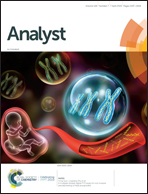Graphene oxide nanosheet-supported Pt concave nanocubes with high-index facets for high-performance H2O2 sensing†
Abstract
As is known, the catalytic activity of metal nanocrystals is strongly affected by their size and shape, and the shape has a greater impact. Among them, metal nanocrystals enclosed by high-index facets have attracted significant attention due to their excellent properties. In this study, platinum concave nanocubes (Pt CNC) with different sizes and angles distributed on polyvinyl pyrrolidone-functional graphene oxide (GO) were synthesized by a one-pot hydrothermal process. The platinum concave nanocubes mainly enclosed by {410}, {510}, and {610} were prepared and used as modified glassy carbon electrodes; cyclic voltammetry and chronoamperometry were applied to investigate the difference between the catalytic activities of platinum concave nanocubes with different facets. The electrodes induced efficient electrocatalysis of hydrogen peroxide (H2O2), and the electrode modified with Pt CNC/rGO-220 showed the highest reduction current. H2O2 was detected with a detection limit of 0.7 μM over two wide linear ranges (from 3 μM to 1 mM and from 1 mM to 0.1 M) and with high sensitivities (757.4 μA mM−1 cm−2 and 315.4 μA mM−1 cm−2), respectively. The modified glassy carbon electrodes also exhibited good stability and selectivity.



 Please wait while we load your content...
Please wait while we load your content...